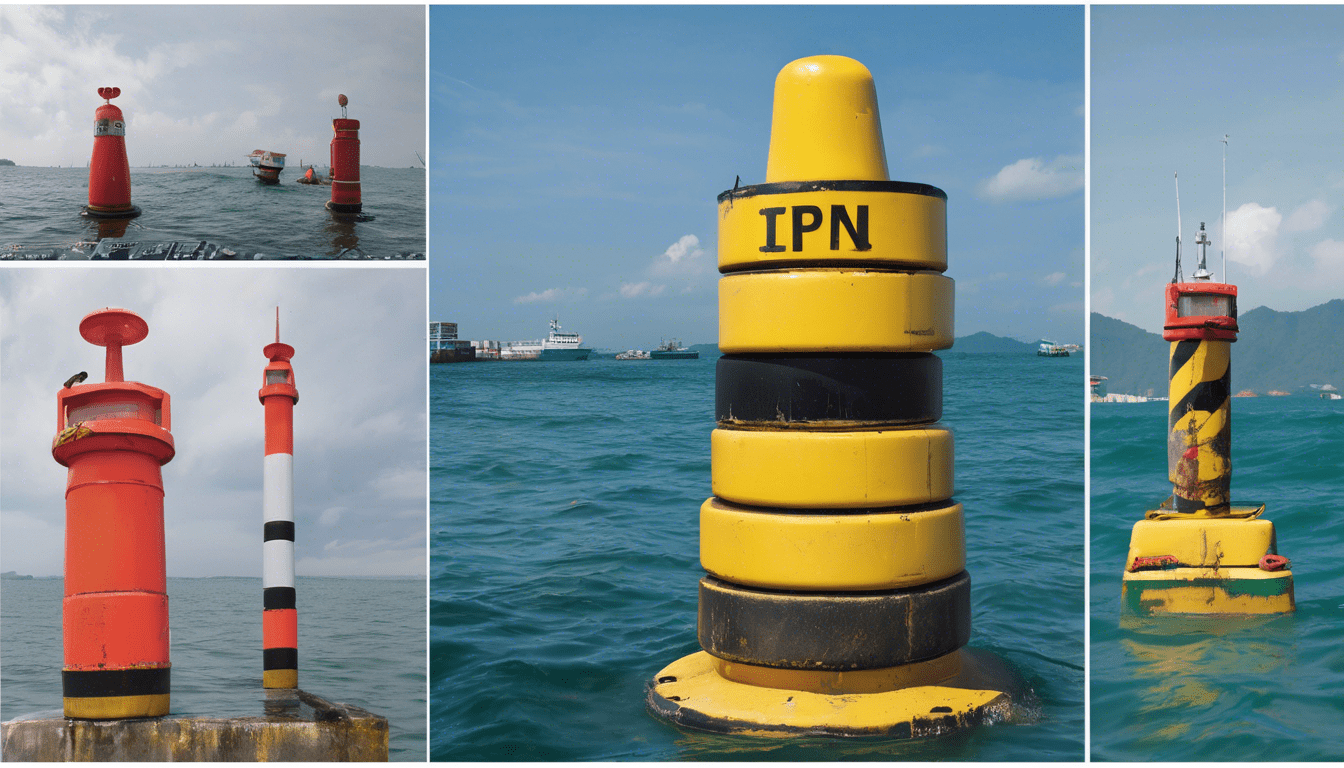Malaysia’s waters rely on a sophisticated network of signalisation buoys that safeguard maritime traffic. These essential markers not only guide vessels but also prevent accidents by warning of hazards and defining routes. Understanding their types, regulations, and maintenance processes reveals a complex system designed with safety and efficiency in mind. This guide offers a comprehensive look at Malaysia’s maritime buoy infrastructure, providing insight into how these floating beacons uphold maritime safety standards in the region.
Overview of Maritime Signalisation Buoys in Malaysia
Maritime signalisation buoys are essential maritime navigation equipment designed to mark safe routes, hazards, and specific zones in water bodies. In Malaysia, these buoys serve a critical function by guiding vessels through busy and sometimes challenging waterways, ensuring safe navigation and preventing accidents. They are strategically placed to indicate channels, underwater obstacles, and anchorage areas, making them indispensable for maritime safety.
Additional reading : Navigating safely: maritime signalisation buoys in malaysia
The importance of maritime signalisation buoys in Malaysian waters cannot be overstated. Malaysia’s extensive coastline, coupled with its significant shipping traffic and fishing activities, demands precise and reliable navigation aids. These buoys reduce the risks of collisions and groundings, protecting both lives and cargo. By providing clear visual and sometimes radar or light signals, they help captains make informed decisions, thus enhancing overall maritime safety.
In Malaysia, the deployment and maintenance of maritime signalisation buoys fall under the jurisdiction of specific regulatory bodies. These authorities ensure that buoy placement complies with international standards and national guidelines, adapting to navigational needs and environmental conditions. They monitor the condition and positioning of buoys regularly to maintain their effectiveness. For those interested in more detailed insights or specific projects related to maritime signalisation buoys in Malaysia, the maritime signalisation buoy project in Malaysia offers comprehensive information on this crucial infrastructure.
In the same genre : What strategies can UK businesses implement for effective talent retention?
Types and Functions of Signalisation Buoys in Malaysia
Understanding the types and functions of signalisation buoys is crucial for safe maritime navigation in Malaysian waters. These buoys serve distinct purposes, guiding vessels and marking hazards effectively. The main categories include lateral marking buoys, cardinal and isolated danger buoys, and special purpose buoys.
Lateral marking buoys are designed to indicate the edges of safe navigation channels. In Malaysia, these buoys typically follow international standards, where red and green colors mark the port and starboard sides of a channel, respectively. Mariners use these visual cues to stay within safe waters, especially in narrow or busy passageways.
Cardinal and isolated danger buoys provide vital warnings about hazards and feature specific positioning information. Cardinal buoys indicate the direction of safe water relative to the buoy (north, south, east, or west), enabling vessels to navigate around dangers accurately. Isolated danger buoys signal specific hazards such as submerged rocks or wrecks directly beneath or near the buoy.
Special purpose buoys in Malaysia address a variety of functions including anchoring, mooring, and conveying important information to mariners. These buoys may be used to mark areas restricted for certain activities or to assist in port operations.
The roles these buoys play directly affect navigation safety, making their proper designation and maintenance a critical aspect of maritime operations. For those interested in detailed operational standards and deployments, exploring the maritime signalisation buoy project in Malaysia provides insightful context into how these buoys are integrated within the local navigational framework.
Regulatory Standards and Guidelines for Buoy Installation in Malaysia
When it comes to buoy installation in Malaysia, adherence to strict regulatory standards is paramount to ensure maritime safety and navigational efficiency. The industry complies with both international and national maritime regulations, prominently including the guidelines set by the International Maritime Organization (IMO) and the Malaysian maritime authority. These bodies establish the framework for safe deployment, maintenance, and operation of maritime signalisation buoys.
Certification and compliance are critical steps in the buoy deployment process. Before installation, a buoy must meet specific technical criteria, verified through comprehensive testing and documentation. This ensures buoys are durable, visible, and technologically equipped to serve their navigational purpose accurately. Maritime authorities require operators—whether governmental or private—to submit detailed plans adhering to these standards. Regular certification renewals are mandated to track ongoing compliance, minimizing risks of malfunction or misplacement.
Proper placement and marking of buoys follow detailed guidelines to facilitate clear navigation. Buoys must be positioned considering local maritime conditions, vessel traffic density, and natural obstacles. Correct colour coding, lighting, and reflective markings conform to international norms, enhancing visibility during day and night operations. This careful placement directly impacts maritime safety, helping prevent collisions or groundings.
Regulatory oversight involves routine inspections carried out by authorized maritime agencies. Such inspections verify that buoys comply with approved standards and remain in effective operational condition. Inspectors assess structural integrity, position accuracy, and electronic functions. These oversight mechanisms strengthen accountability among operators and contribute to the overall reliability of Malaysia’s navigational system, supporting safe marine activities such as shipping, fishing, and leisure boating.
For insight into specific projects adhering to these stringent standards, the maritime signalisation buoy project in Malaysia presents an excellent example of regulatory compliance in practice.
Installation and Maintenance of Signalisation Buoys
The installation and maintenance of signalisation buoys are critical components to ensure maritime safety and effective navigation. Successful deployment starts with a thorough site assessment based on specific selection criteria. These criteria include water depth, tidal patterns, weather conditions, and maritime traffic density. By carefully evaluating these factors, authorities can determine optimal buoy locations to maximize visibility and effectiveness.
Deployment techniques employ specialized equipment such as anchor chains, winches, and GPS tracking systems to secure buoys in position. Precision during installation is essential to maintain buoy stability and alignment with maritime navigation standards. Safety protocols must be strictly followed to protect installation crews and vessels from hazards like strong currents and adverse weather.
Routine inspection is equally important. Maintenance crews regularly check buoy integrity, lantern functionality, and anchoring systems. This ensures ongoing compliance with safety regulations and operational reliability. Upgrading and replacement involve the systematic removal of outdated buoys followed by installation of modern units featuring improved visibility and technology adaptations.
Special challenges arise when working in remote or difficult areas. Crew access may be limited by weather or sea state, and logistical support can be complicated. Despite these issues, maintaining signalisation buoys in all locations is vital. For detailed technical insights into regional applications, readers are encouraged to explore the maritime signalisation buoy project in Malaysia, which exemplifies comprehensive installation and maintenance practices in challenging environments.
Regional Variations and Navigation Considerations in Malaysia
Understanding regional variations in maritime signalisation buoy placement is crucial for safe navigation across Malaysia’s diverse waters. The country’s geography results in distinct differences between maritime zones, especially between the East Coast and West Coast. These differences affect buoy types, positions, and the overall navigation strategy.
The East Coast of Malaysia features more dynamic and challenging conditions due to seasonal monsoons. Buoy placement here often adapts to fluctuating water depths and strong currents. Conversely, the West Coast benefits from relatively calmer seas but deals with complex shipping lanes near busy ports like Port Klang. Navigators must recognize these distinctions to effectively interpret buoy signals.
Seasonal weather changes profoundly influence buoy positioning and maintenance. During monsoon seasons, some buoys require repositioning or reinforcing to remain reliable. Moreover, maritime traffic patterns vary throughout the year, prompting adjustments in navigation aids to manage congestion and ensure clear passage. These adaptive strategies underscore the responsive nature of the maritime signalisation buoy project in Malaysia.
Effective navigation also relies on integrating buoys with other aids such as radar beacons, GPS systems, and coastal markers. This multi-layered approach provides mariners with comprehensive situational awareness, reducing the risk of accidents. In congested or complex areas, precise buoy placement combined with up-to-date technological systems ensures safer navigation.
To summarize, recognizing regional maritime navigation differences, accounting for seasonal variations, and combining buoy systems with modern navigation tools constitute the backbone of Malaysia’s maritime safety framework. Detailed knowledge of these factors is indispensable for any vessel operating in Malaysian waters. For more insights, the maritime signalisation buoy project in Malaysia offers extensive information on current navigational aid deployments and ongoing enhancements.
Safety Standards and Best Practices for Marine Authorities and Marine Users
Proper safety standards form the backbone of effective maritime navigation, mandating that all maritime signalisation buoys maintain visibility and robustness under diverse environmental conditions. Ensuring these buoys remain conspicuous requires adherence to strict guidelines on materials, reflectivity, and color coding, which marine authorities enforce to help vessels recognize navigational markers promptly.
A key aspect of these standards involves robust maintenance schedules. These schedules consolidate best practices that outline the frequency and methods for inspecting and servicing buoys. Regular maintenance mitigates risks associated with buoy deterioration or displacement, which can lead to navigational errors. Comprehensive operational protocols also include systematic checks for buoy anchors, light sources, and electronic components, maximizing buoy reliability and compliance.
In addition, marine personnel undergo rigorous training to uphold these safety standards. Training programs focus on proper installation procedures, real-time monitoring, and emergency response tactics related to maritime signalisation buoys. Through this, marine users and authorities alike build expertise that ensures maritime safety is never compromised.
Collectively, these safety standards and best practices enhance overall maritime security, supporting vessels in identifying hazards promptly while navigating diverse waterways. For those interested in specific implementations and collaborations, examining the maritime signalisation buoy project in Malaysia offers further insight.
Review of Existing Marine Signalisation Buoy Systems in Malaysia
An analysis of current deployment and performance
Malaysia’s marine signalisation buoy systems serve as crucial aids to navigation, marking safe passage routes and hazards effectively. Deployment coverage spans busy shipping lanes, harbor entrances, and strategic coastal points, enhancing overall navigation safety. Their presence helps reduce accidents, particularly in congested waters where clear maritime signals prevent vessel collisions and groundings.
Success stories emerge from reports in regions like the Straits of Malacca and Johor Strait, where buoy systems have significantly improved navigational clarity for both commercial and fishing vessels. These systems have enabled safer port approaches and smoother traffic management. However, gaps remain: some remote or rapidly changing coastal zones lack updated buoy placements, leading to navigational uncertainty in adverse weather or strong currents.
Regional maritime authorities acknowledge these discrepancies and emphasize upgrades focusing on modernization and broader buoy coverage. Future plans include integrating advanced technologies such as GPS-linked buoys and real-time monitoring systems to enhance reliability. These efforts aim to ensure navigators receive consistent, unmistakable signals, reducing near misses and maritime incidents.
For those interested in Malaysia’s initiatives to further improve sea safety, exploring the development projects of the maritime signalisation buoy project in Malaysia offers deeper insight into ongoing advancements. This demonstrates a proactive effort to align with international standards while tailoring solutions to local maritime conditions.







